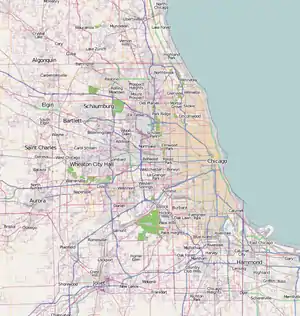Jean Baptiste Point Du Sable Homesite
The Jean Baptiste Point Du Sable Homesite is the location where, around the 1780s, Jean Baptiste Point du Sable located his home and trading post.[2] This home is generally considered to be the first permanent, non-native, residence in Chicago, Illinois.[3] The site of Point du Sable's home is now partially occupied by and commemorated in Pioneer Court at 401 N. Michigan Avenue in the Near North Side community area of Chicago, Illinois.[4]
Jean Baptiste Point Du Sable Homesite | |
 | |
   | |
| Location | Pioneer Court, Chicago, IL |
|---|---|
| Coordinates | 41°53′22.78″N 87°37′24.28″W |
| Area | about 1 acre (0.40 ha) |
| Built | 1779 |
| NRHP reference No. | 76000690 [1] |
| Significant dates | |
| Added to NRHP | May 11, 1976 |
| Designated NHL | May 11, 1976[2] |
History
Point du Sable likely settled near the mouth of the Chicago River sometime around the 1780s and sold the property in 1800. He lived here with his wife, Kitihawa, and children. The 1800 bill of sale was rediscovered in 1913 in an archive in Detroit, Michigan.[5] The property included a house, two barns, a horse drawn mill, a bakehouse, a poultry house, a dairy, and a smokehouse. Their house was a 22-by-40-foot (6.7 m × 12.2 m) log cabin filled with fine furniture and paintings.[5]
Following Point du Sable's departure from Chicago, the home became the property of John Kinzie. In 1834 the land owned by Kinzie was platted and sold.[6] The "Kinzie addition" to Chicago, which is assumed to be coterminous with Point du Sable's estate extended from the banks of the Chicago River north to Chicago Avenue, and from State Street east to Lake Michigan.[4]
Monument
A commemorative plaque, struck in 1937, was installed on a marble block at Pioneer Court after its 1965 dedication. It reads, "KINZIE MANSION / Near this site stood Kinzie Mansion, / 1784-1832, home of Pointe Du Saible, / Le Mai, and John Kinzie, Chicago's / "first civilian," here was born in 1805, / the city's first white child Ellen Marion Kinzie".[4] While the plaque is correct that Ellen Marion Kinzie was the first white child born in the city, Du Sable's granddaughter, Eulalie Pelletier, was the first non-native to be born in the city, in 1796.[4]
Pioneer Court was listed on the National Register of Historic Places and listed as a National Historic Landmark on May 11, 1976.[2] At this site in 2009 the City of Chicago and a private donor erected a large bronze bust of Point du Sable by Chicago-born sculptor Erik Blome.[7] In October 2010 the adjacent Michigan Avenue Bridge was renamed DuSable Bridge in honor of Point du Sable.
See also
Notes
- "Du Sable, Jean Baptiste Point, Homesite". National Register of Historic Places. National Park Service. August 25, 2010.
- "Du Sable, Jean Baptiste Point, Homesite". National Historic Landmark summary listing. National Park Service. Archived from the original on November 23, 2007. Retrieved July 20, 2008.
- Swenson, John W (1999). "Jean Baptiste Point de Sable—The Founder of Modern Chicago". Early Chicago. Early Chicago, Inc. Retrieved September 6, 2010.
- "Jean Baptiste Point Du Sable Homesite". National Register of Historic Places Inventory. National Park Service. Retrieved September 6, 2010.
- Quaife, Milo Milton (June 1928). "Property of Jean Baptiste Point Sable". The Mississippi Valley Historical Review. 15 (1): 89–96. JSTOR 1891669.
- "Kinzie Addition". Early Chicago. Early Chicago Inc. Retrieved September 6, 2010.
- "DuSable bust dedicated in Chicago". ABC7 news. October 17, 2009. Archived from the original on June 29, 2011. Retrieved November 25, 2010.
| Wikimedia Commons has media related to Jean Baptiste Point Du Sable Homesite. |